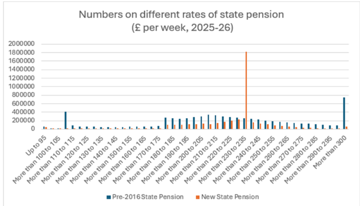Further tax allowance freeze set to drag at least another half million pensioners into tax net – but total could reach 10m by end of decade
This content is AI generated, click here to find out more about Transpose™.
For terms of use click here.

Modelling by LCP partner Steve Webb has found that if the Chancellor were to extend the freeze on income tax thresholds for another two years, this would mean an extra half million state pensioners paying income tax – even allowing for the increase in pension age from 66 to 67.
This means at least 9.3m pensioners paying tax, around three quarters of all pensioners, compared with around 8.7m today. But if inflation or wage growth picks up in the coming years, leading to larger state pension rises, we could easily see 10m pensioners paying income tax by the end of the decade.
Other key findings in the research paper are:
- In 2021/22, when the freeze started, the new state pension was around three quarters of the tax threshold; in 2027/28, even with just a 2.5% ‘triple lock’ increase in the state pension, the new state pension will be 102% of the tax threshold; in 2021/22 there were around 6.7m pensioners paying tax compared with 8.7m today;
- However, there are *already* three million pensioners with total state pensions over the tax threshold; around 2.5 million of these are people on the *old* state pension whose basic pension plus additional (SERPS) pension already takes them into the tax net;
- Although more pensioners are paying tax, most do not have to file a tax return; those with a company pension etc. will have their tax collected via a PAYE tax code from the pension provider; those with no company pension but simple tax affairs will simply be sent a bill by HMRC at the end of the year under the ‘simple assessment’ process;
- The freezes affect not just the starting point for paying basic rate tax, but also the starting point for 40% and 45% tax; this year just over 1 million pensioners will pay tax at 40% or above – a doubling compared with just under half a million four years ago.
The chart below shows the different amounts of state pension received each week, split by whether people are on the old (pre 2016) or new state pension system.

As the chart shows, although the biggest concentration of pensioners is at the standard rate of the new state pension, the majority of pensioners retired under the old system and have a much more diverse range of outcomes. This includes around 2.5m on the old system whose state pension on its own takes them above the income tax threshold.
Commenting, Steve Webb, partner at pension consultants LCP said: “A combination of high inflation and frozen tax thresholds has led to a surge in the number of pensioners paying tax, and in the numbers paying at 40% or above. If the Chancellor decides to freeze thresholds for another two years, we will see at least half a million more pensioners dragged into the tax net as a minimum, taking the total to around 9.3m – three quarters of all pensioners. But if inflation or wage growth picks up, that total could reach 10m pensioner taxpayers by the end of the decade”.
“The majority of today’s pensioners retired under the old state pension system and around 2.5m of them already have a state pension above the income tax threshold. But from 2027/28, anyone on the full rate of the new state pension will also be above the tax threshold based on their state pension alone. The one bit of good news is that most of these pensioners will not need to fill in a tax return. Any tax due will usually be collected via a tax code on their private pensions or through the ‘simple assessment’ process which involves HMRC using information it already holds to work out a tax bill”





